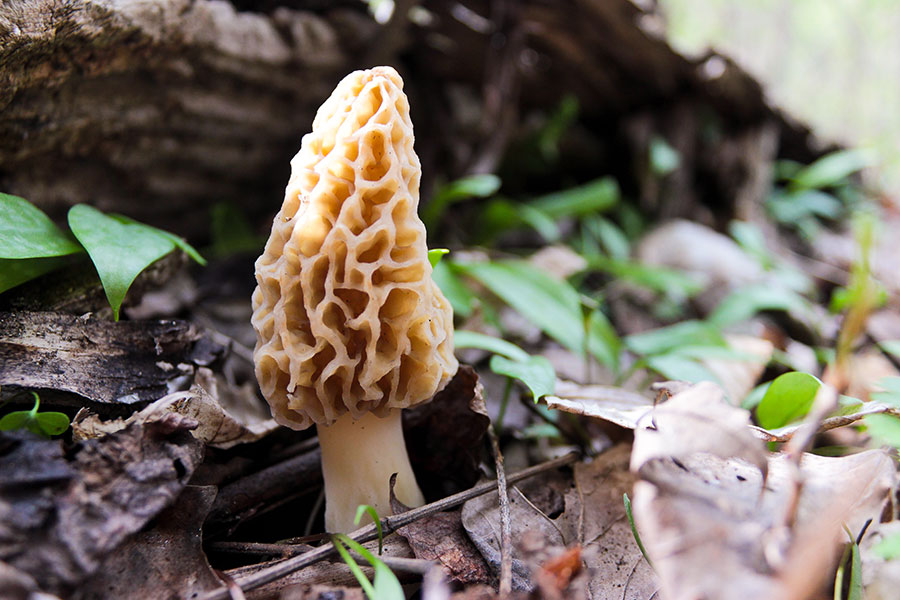
MUSHROOMS can be deadly! They have gills but aren’t fish (obviously), they aren’t vegetables and can hardly be considered “plants” – without roots, leaves, flowers or seeds. What are they, then? They’re part of the fungi kingdom. Don’t worry, culinary mushrooms from the produce aisle in grocery stores are cultivated and safe to consume1, unlike some of the wild mushrooms picked up during foraging. Here are three reasons why you shouldn’t avoid the mysterious living organisms known as mushrooms:
Nutrition
Mushrooms contribute to a plant-based diet high in nutrients2, though content varies based on mushroom variety. They are low in fat and calories, high in carbohydrates, fiber, protein3 (by calories), B vitamins, phosphorus, potassium, as well as magnesium, selenium, copper, and Vitamin D. Mushrooms are the only “plant” that provides a natural source of vitamin D, from the conversion of ergosterol to D2 or D4 when exposed to ultraviolet light (look for “UV-treated” on the label). Shiitake and morel varieties naturally contain more vitamin D than other mushrooms typically consumed by Americans4. To offer protein equal to that from an ounce of meat, it takes about two cups of white button mushrooms – a significant quantity that contributes to fullness and decreased hunger but provides only 42 calories.
Health
Though hundreds of mushrooms have medicinal and disease-fighting properties1,3, Japanese varieties notably contain the most phytochemicals (naturally occurring plant chemicals)2. Oyster mushrooms contain antioxidants such as selenium and L-ergothioneine, which provide protection to cells against free radical damage2. These compounds are fortunately resistant to cooking2. King trumpet (aka. king oyster) also contains statins shown to reduce blood lipids2.
Additionally, white and brown beech, shiitake and maitake mushrooms contain beta-glucan fiber2 which may help lower insulin resistance, blood cholesterol, and risk of obesity5. Mushroom beta-glucans may not affect glucose absorption, but they could decrease the glycemic response by up to 25%5. Portobellos can lower glycemic responses when consumed with food1. Japanese studies of isolated beta-glucans from mushrooms show promise to boost the immune response to fight cancer cells3,5 and may help prevent the recurrence of hormone-dependent breast cancers1,3.

Cuisine
Mushrooms offer umami, the 5th basic taste after sweet, salty, bitter and sour. The darker the mushroom the more umami it contains, and cooking intensifies this flavor1,2. Mushrooms are known for their unique earthy flavor and chewy, meaty texture1. White button mushrooms are milder than their darker counterparts, crimini (aka “baby bellas”) which are immature portobello mushrooms3. Dried versions of most types have super-concentrated flavor and make great additions to soups, sauces, and stocks.
Mushrooms are great for trimming meat in dishes or used as a stand-out ingredient in stir-fries (shiitake best) or raw salads (enoki best)1. For those who have a palate issue with them on their own, finely dicing mushrooms to match the consistency of meat then blending into traditional recipes alongside ground meat, makes them more tolerable1. To cut back on meat you can use finely diced mushrooms as replacement for half the ground beef in tacos, lasagna, meatballs/loaves, burgers, and pasta sauce1.



MYCOPROTEIN is a mold member of the fungi family. Wait, what? We are told to avoid mold on foods because it is dangerous! Approved in 2001 by the FDA as a Generally Recognized As Safe (GRAS) food, mycoprotein is grown in large fermentation vats. Mycologists have studied the safety of the mold strain used and determined it produces an almost undetectable less than 0.5 parts per million mycotoxins in production6.
Mycoprotein is high in fiber and protein (12% protein by weight) and contains all essential amino acids in concentrations similar to egg6. Due to its stringy nature, it is predominantly used as a meat substitute, though modified mycoprotein can also be used as a fat replacer in dairy products or as a grain replacement in cereals.
As with all foods, some people may be intolerant or allergic (rare) to mycoprotein. Such cases have prompted the nonprofit Center for Science in the Public Interest to request that the FDA revoke mycoprotein’s GRAS status. If you are looking for a non-soy, non-dairy vegetarian protein source then you might consider mycoprotein. On the other hand, if you are looking for natural ‘clean’ foods, then these highly engineered mycoprotein products are not for you.
In summary, there are benefits to mushrooms including some that other plants can’t provide, while mycoprotein’s only value seems to be as a meat replacer. Now that you’re armed with details about each, don’t let edible fungi haunt you!
References:
- Fabulous Fungi — Here’s Why Your Clients Should Be Trading Meat for Mushrooms
L Getz.Today’s Dietitian Dec. 2014; 16 (12): 14-15. - From A to Shiitake — Japanese Mushrooms May Offer Certain Benefits. LK Kay.Today’s Dietitian Nov. 2010; 12 (11): 20-21.
- Medicinal Mushrooms. J Ilkay. Today’s Dietitian Sept. 2011; 13(9): 30-32.
- Are Mushrooms a Significant Source of Vitamin D? Journal of The Academy of Nutrition and Dietetics Sept 2016; 116(9): 1520.
- Betting on Beta-Glucans. D Webb. Today’s Dietitian May 2014; 16(5): 16-17.
- Food Mycology: A Multifaceted Approach to Fungi and Food. J Dijksterhuis, RA Samson. CRC Press, 2007.

Grilled Stuffed Portobellos

Ingredients
The gills on the underside of portobello caps have an unpleasant chalkiness and, therefore, should be scraped away with a spoon before grilling. Olives and feta cheese tend to be salty so keep that in mind when seasoning to taste.
- large portobello mushrooms, stemmed
- 2 T balsamic vinegar
- 2 T extra-virgin olive oil
- Fine sea salt and pepper
- 1/2 cup jarred roasted red peppers, chopped
- 1/4 cup pitted kalamata olives, chopped
- 1 garlic clove, minced
- 11/2 tsp chopped fresh oregano
- 2 oz crumbled feta cheese (1/2 cup)
Method
- Using a spoon, scrape out the gills from the underside of the mushrooms and discard. Gently toss the mushrooms together with the vinegar, 1 T of oil, and salt and pepper to taste in a large bowl, taking care to not break the mushrooms. Let sit for 10 minutes while the mushrooms absorb the marinade.
- Combine the peppers, olives, remaining 1 T of oil, garlic, and oregano in a small bowl, and season with salt and pepper to taste.
- Prepare a hot fire on the grill. Place the mushrooms gill side up on the grill directly over the fire and cook, covered, until well browned on the first side, about 5 minutes.
- Flip the mushrooms and continue to cook, covered, until well browned on the second side, about 5 minutes.
- Finally, flip the mushrooms one last time (they should be gill side up again) and spoon the pepper-olive mixture evenly among them. Top each mushroom with feta cheese and grill, covered, for 1 minute longer. Using a spatula, transfer the mushrooms to a platter and serve.
Serves 4 as a side dish
Nutrient Analysis per serving: Calories: 180; Total fat: 13 g; Sat fat: 3 g; Cholesterol: 5 mg; Sodium: 470 mg; Total carbohydrate: 11 g; Dietary fiber: 2 g; Sugars: 6 g; Protein: 7 g
Recipe Credit: Mushrooms — A Unique Ingredient Taken From Forest Floor to Kitchen Door. Bryan Roof. Today’s Dietitian, Aug 2012; 14(8); 74
Recommended Reading
LA Fitness 4th of July and Canada Hours 2022
LA Fitness will be open for Independence Day and Canada Day! Modified clubs hours are below!Holiday Hours (U.S.) Monday, July 4th: 8AM - 4PM Tuesday, July 5th: Normal Hours Holiday Hours (Canada) Friday, July 1st: 8AM - 4PM Saturday, July 2nd: Normal Hours ...
LA Fitness Holiday Hours 2021
LA Fitness will be open for parts of the Holiday Season! Modified clubs hours are below!Holiday Hours (U.S.) Friday, December 24th: 8AM - Noon Saturday, December 25th: Closed Friday, December 31st: 8AM - 6PM Saturday, January 1st: 8AM - 6PM Holiday Hours...
3 Year Anniversary – Living Healthy Podcast Update
Today is the 3rd Anniversary of the Living Healthy Podcast, presented by LA Fitness. Hi everyone! I just wanted to give you a quick update on what is going on with the show. We are trying to plan out 3 LIVE podcast episodes covering Exercise, Nutrition, and Sleep...


